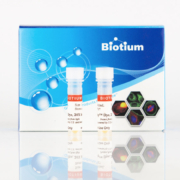Biotium introduces EvaRuby Dye for qPCR and HRM
Biotium, a leading life science reagent supplier and inventor of the widely used ‘EvaGreen’ qPCR Dye, has released ‘EvaRuby’ Dye for qPCR and HRM. This spectrally unique red fluorescent intercalating dye can be incorporated into probe-based qPCR assays, expanding multiplexing options for probe-based qPCR. EvaRuby Dye is compatible with ~470 nm excitation and ~610 nm emission filters.
While a variety of DNA binding dyes with different fluorescence emission properties have been published for use in qPCR and HRM, only the green fluorescent dyes SYBR Green I, SYTO 9, and EvaGreen Dye have widespread use in these applications. EvaGreen Dye is currently the only dye suitable for qPCR and HRM in the same reaction, however, due to its relatively broad emission, EvaGreen cannot be combined with red PCR probes for multiplexing or HRM in probe qPCR reactions.
As a solution, Biotium scientists have developed EvaRuby, a unique dye with a much longer Stokes shift of 480/613 nm (excitation/emission). This allows excitation of EvaRuby Dye by the same green/blue channel as EvaGreen Dye, and detection in the orange (JUN or ROX) channel. As a result, EvaRuby Dye has minimal cross-talk in standard probe detection channels and enables the combination of dye-based and probe-based qPCR in a single reaction. In addition, EvaRuby Dye is validated for HRM analysis and may be used as an internal control for probe-based qPCR to detect non-specific amplification that goes undetected by target-specific probes. EvaRuby Dye is also suitable for singleplex qPCR, LAMP, and gel electrophoresis.
EvaRuby Dye has been validated on Applied Biosystems QuantStudio 5 96-well and Qiagen Rotor-Gene Q instruments, with potential compatibility for other qPCR instruments capable of acquiring data using ~470 nm excitation and ~610 nm emission filters.
Features and benefits of EvaRuby Dye include:
- Spectrally Unique: Minimal cross-talk in neighboring channels
- Flexible: Unique red dye that expands multiplexing capabilities for probe-based qPCR
- Versatile: Can combine probe-based qPCR with HRM in the same reaction
- Convenient: Easily confirm your results with melt curve analysis rather than time consuming post-qPCR gel electrophoresis
The release of EvaRuby Dye adds to Biotium’s industry-leading catalogue of qPCR reagents for life science research.
- For more information, visit: biotium.com/product/evaruby-dye-20x-in-water/




